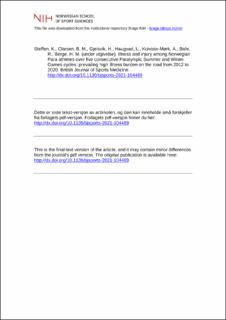| dc.description.abstract | Objective: To describe the illness and injury pattern of Norwegian Para athletes over five consecutive Paralympic Summer and Winter Games cycles and to identify which health problems should be targeted in risk management plans with respect to impairment types. Methods: We monitored athletes from 12 to 18 months prior to each Game using a weekly online questionnaire (Oslo Sports Trauma Research Center-H2 (OSTRC-H2)). We asked them to report all health problems they had experienced in the preceding 7 days, irrespective of their consequences on their sports participation or performance and whether they had sought medical attention. Results: Between 2011 and 2020, 94 candidate athletes were included in this monitoring programme and prepared to represent Norway; of these, 66 (71%) were finally selected for multiple Paralympic Games. The overall response rate to the weekly questionnaires was 87%. At any given time during the five observation cycles, 37% of the athletes (95% CI 36% to 38%) reported having at least one health problem. Athletes with neurological impairments (n=51) lost 10 days per year due to respiratory problems (95% CI 9 to 11) compared with 9 days (8-10) among those with musculoskeletal impairments (n=37). Gastrointestinal problems caused a time loss of on average 4 days per year in athletes with neurological impairments versus 1 day in athletes with musculoskeletal impairments (mean difference 2.7 days, 2.1–3.3). Musculoskeletal injuries generated a high burden for both athlete groups, in particular, to the elbow, shoulder and lumbosacral regions. Conclusion: At any given time, nearly two out of five elite Norwegian Para athletes reported at least one health problem. Respiratory tract and other infections; gastrointestinal problems, injuries to the shoulder, elbow and lumbosacral regions represented the greatest health burden. Our findings can help guide the allocation of clinical resources, which should include a broad network of medical specialists, together with dieticians and physiotherapists, to meet the health challenges in Para athletes. | |
